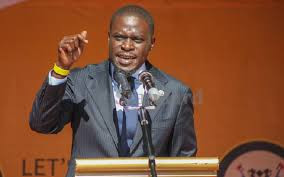If you take any matatu plying Ngong Road in Nairobi, you can choose to alight at Community.
It is up the hill from the city’s central business district and offers a bird’s eye view of downtown Nairobi. A number of ministries have their headquarters there. The national library, High Court and prisons service also have a presence.
The name Community dates back to the time when the East African Community — made up of Kenya, Uganda and Tanzania — thrived and shared a lot of services, from railways and harbours to universities, airlines and even a currency.
The community broke up in 1977 but was revived in 1999, roping in Burundi and Rwanda, and more recently, South Sudan. We need to include Somalia, too.
The idea of a community was ahead of its time, and it is unfortunate we let it die. We were in sync with the European Union and prospects were getting brighter.
The Community area adjoins Upper Hill (where is Lower Hill?), which has undergone one of the most dramatic urban redevelopments in recent times. Personal homes were replaced by skyscrapers that now compete on height, elegance and design.
It is not clear why developers flocked to this place. Was it the view or affordable land prices?
What we know now is that major multinational corporations, from banks and hotels to embassies, have offices in Upper Hill.
Downtown seems to have been left to the Government and, curiously, universities. Interestingly, the Teachers Service Commission has put up new offices in Upper Hill.
The redevelopment of Upper Hill went beyond the East African Community dream. Across the road from where we used to have the EAC headquarters, we now have the headquarters of multinational corporations. The local dream has become a global dream.
Roads have been redone and driving through this part of Nairobi makes one feel there is something going on in the city. Does the Kenya Tourist Board market this place as one of the country’s attractions in addition to the Big Five?
Lessons from redevelopment
One wishes all other parts of Nairobi and other towns would undergo such redevelopment — I’m avoiding the word gentrification as the place was never run down.
What led to this redevelopment and what lessons can we derive from it? The traffic jam in Nairobi and lack of parking most likely drove the big firms to Upper Hill where they could get a new start and build offices to their specifications and liking.
Once the big firms like Coca-Cola and banks put up new offices, it was a matter of time before service providers followed them. Hotels such as Crowne Plaza and Raddison Blu came calling. Even the World Bank is there.
Stay informed. Subscribe to our newsletter
Upper Hill has become a self-contained ecosystem, with many types of businesses feeding into each other. From banking to insurance, engineering and diplomacy, they all have their place in Upper Hill.
Leisure was not left behind. You can go to the gym at Nairobi Club if you are a member. You can play golf at Railway Club. Even sickness is taken care of; Kenyatta and Nairobi hospitals and many other specialised clinics are nearby. Government services are also close by. The airport is 15 kilometres away and the national park 10 kilometres away.
Once such an ecosystem is built, it gets a life of its own. It also tends to suck wealth from other parts of the city, counties and even the world. Upper Hill represents what Nairobi should be — in a perpetual state of renewal driven by the creative genius of entrepreneurs.
One could ask if the Government was behind the rebirth of Upper Hill. The answer is likely no. The roads in Upper Hill only got a facelift after the buildings were up and running.
Upper Hill is a testimony to the wonders of the invisible hand of the market. Can you compare Upper Hill with Konza City, which is being driven by the visible hand of the Government?
The March 2016 World Bank report on Kenya, From Growth to Jobs and Shared Prosperity, identifies urbanisation as one the key drivers of economic growth, in addition to innovation and oil. Upper Hill seems ahead of the report. Its economic boldness should be replicated throughout the country.
Will towns in other parts of the country follow suit and renew themselves? Towns like Nakuru and Eldoret are bursting at the seams and need expansion.
I do not think land is the biggest problem in most towns. Rather, it is attracting investors and their money. Investor conferences have been held in counties to showcase opportunities, but which opportunities are these that the private sector has not seen?
Upper hand
Upper Hill has the upper hand over other parts of Nairobi, and the money is coming in from all over the world. Which other town can marshal such investment? Despite the presence of slums, Nairobi is still a magnet. No wonder MCAs and governors are never far from the city centre.
Other towns lack incentives, such as good transport networks and tolerance of diversity. Once you are in Nairobi, we forget your tribe, colour and origin. We see you as an investor and respect you for your ability to make money — though not always legally.
Unfortunately, most counties are yet to see the importance of diversity, which is Nairobi’s greatest asset. The inward thinking in counties is their soft underbelly.
Upper Hill’s bold economic miracle is a microcosm of a golden future when capital, innovations and new thinking will flow freely, unhindered by our prejudices, stereotypes and short-termism. One wishes that future would arrive prematurely.
The writer is senior lecturer, University of Nairobi.
 The Standard Group Plc is a
multi-media organization with investments in media platforms spanning newspaper
print operations, television, radio broadcasting, digital and online services. The
Standard Group is recognized as a leading multi-media house in Kenya with a key
influence in matters of national and international interest.
The Standard Group Plc is a
multi-media organization with investments in media platforms spanning newspaper
print operations, television, radio broadcasting, digital and online services. The
Standard Group is recognized as a leading multi-media house in Kenya with a key
influence in matters of national and international interest.
 The Standard Group Plc is a
multi-media organization with investments in media platforms spanning newspaper
print operations, television, radio broadcasting, digital and online services. The
Standard Group is recognized as a leading multi-media house in Kenya with a key
influence in matters of national and international interest.
The Standard Group Plc is a
multi-media organization with investments in media platforms spanning newspaper
print operations, television, radio broadcasting, digital and online services. The
Standard Group is recognized as a leading multi-media house in Kenya with a key
influence in matters of national and international interest.








